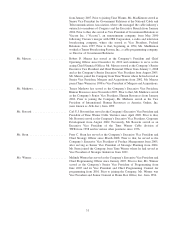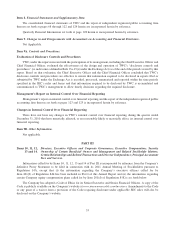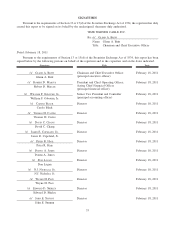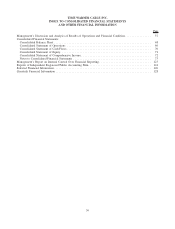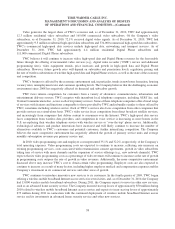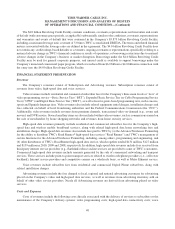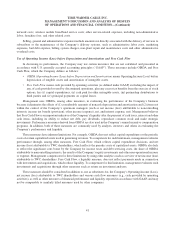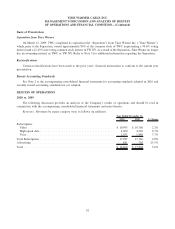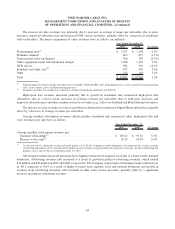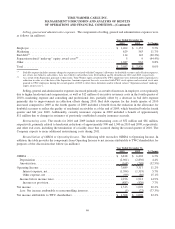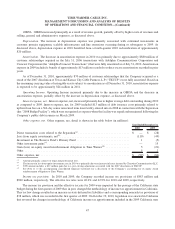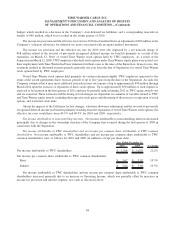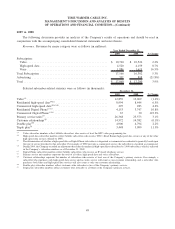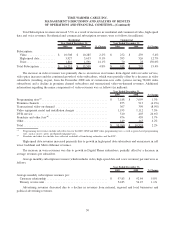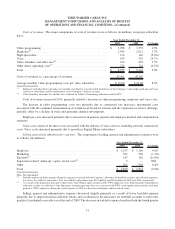Time Warner Cable 2010 Annual Report Download - page 53
Download and view the complete annual report
Please find page 53 of the 2010 Time Warner Cable annual report below. You can navigate through the pages in the report by either clicking on the pages listed below, or by using the keyword search tool below to find specific information within the annual report.network costs; wireless mobile broadband service costs; other service-related expenses, including non-administrative
labor; franchise fees; and other related costs.
Selling, general and administrative expenses include amounts not directly associated with the delivery of services to
subscribers or the maintenance of the Company’s delivery systems, such as administrative labor costs, marketing
expenses, bad debt expense, billing system charges, non-plant repair and maintenance costs and other administrative
overhead costs.
Use of Operating Income (Loss) before Depreciation and Amortization and Free Cash Flow
In discussing its performance, the Company may use certain measures that are not calculated and presented in
accordance with U.S. generally accepted accounting principles (“GAAP”). These measures include OIBDA and Free
Cash Flow, which the Company defines as follows:
•OIBDA (Operating Income (Loss) before Depreciation and Amortization) means Operating Income (Loss) before
depreciation of tangible assets and amortization of intangible assets.
•Free Cash Flow means cash provided by operating activities (as defined under GAAP) excluding the impact, if
any, of cash provided or used by discontinued operations, plus any excess tax benefits from the exercise of stock
options, less (i) capital expenditures, (ii) cash paid for other intangible assets, (iii) partnership distributions to
third parties and (iv) principal payments on capital leases.
Management uses OIBDA, among other measures, in evaluating the performance of the Company’s business
because it eliminates the effects of (1) considerable amounts of noncash depreciation and amortization and (2) items not
within the control of the Company’s operations managers (such as net income (loss) attributable to noncontrolling
interests, income tax benefit (provision), other income (expense), net, and interest expense, net). Management believes
that Free Cash Flow is an important indicator of the Company’s liquidity after the payment of cash taxes, interest and other
cash items, including its ability to reduce net debt, pay dividends, repurchase common stock and make strategic
investments. Performance measures derived from OIBDA are also used in the Company’s annual incentive compensation
programs. In addition, both of these measures are commonly used by analysts, investors and others in evaluating the
Company’s performance and liquidity.
These measures have inherent limitations. For example, OIBDA does not reflect capital expenditures or the periodic
costs of certain capitalized assets used in generating revenues. To compensate for such limitations, management evaluates
performance through, among other measures, Free Cash Flow, which reflects capital expenditure decisions, and net
income (loss) attributable to TWC shareholders, which reflects the periodic costs of capitalized assets. OIBDA also fails
to reflect the significant costs borne by the Company for income taxes and debt servicing costs, the share of OIBDA
attributable to noncontrolling interests, the results of the Company’s equity investments and other non-operational income
or expense. Management compensates for these limitations by using other analytics such as a review of net income (loss)
attributable to TWC shareholders. Free Cash Flow, a liquidity measure, does not reflect payments made in connection
with investments and acquisitions, which reduce liquidity. To compensate for this limitation, management evaluates such
investments and acquisitions through other measures such as return on investment analyses.
These measures should be considered in addition to, not as substitutes for, the Company’s Operating Income (Loss),
net income (loss) attributable to TWC shareholders and various cash flow measures (e.g., cash provided by operating
activities), as well as other measures of financial performance and liquidity reported in accordance with GAAP, and may
not be comparable to similarly titled measures used by other companies.
41
TIME WARNER CABLE INC.
MANAGEMENT’S DISCUSSION AND ANALYSIS OF RESULTS
OF OPERATIONS AND FINANCIAL CONDITION—(Continued)


